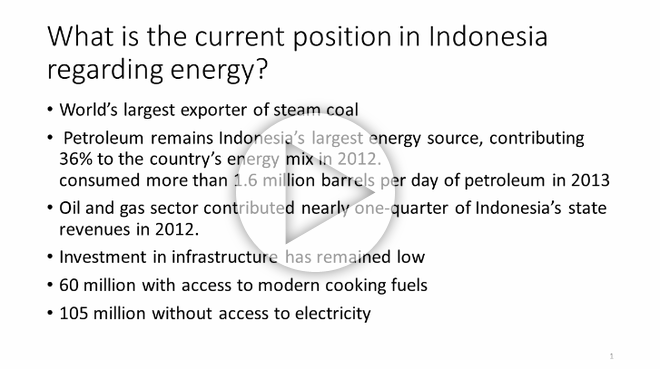Indonesia Perspectives: Energy
Seminar Speakers
- Amy Sopinka, Energy Policy Advisor, North American Energy Markets1
- Verina Wargadalam, is a Researcher at the Ministry of Energy and Mineral Resources
Seminar Presentation by Amy Sopinka:
Background
Indonesia has vast reserves of fossil fuels and is a major exporter of coal and liquefied natural gas. The overall energy sector is a large one, accounting for 15.6% of GDP. Energy has also made its contribution towards the country’s 6% annual growth rate over recent years. But despite the strength of the economy and these energy reserves, nearly half the rural population has no access to electricity, and 42% of the nearly quarter of a billion population cook using traditional fuels, including firewood, leaves and animal dung.
90% of people in towns have electricity, and bringing the rural population up to the same standard would be a great improvement. Not only that, but providing clean, gas-fired cooking stoves for everyone would reduce the burden of poor health and death caused by indoor air pollution.
With over 40% of Indonesians living on less than 25,000 IDR a day, despite overall economic growth, it is not surprising that the government’s policy to subsidise a whole range of energy products has been very popular. However, by 2014, these subsidies accounted for over 20% of central government spending and disproportionately benefitted richer households. After all, it is only the better-off who can afford motorbikes, cars and fuel.
The amount spent on subsidies was three times greater than the budgets for health or infrastructure. Despite their popularity, energy subsidies cost the country 1,650 trillion IDR over the last five years, with little apparent benefit. Making this money available for other uses could help to provide electricity and clean cooking stoves for more of the population, as well as improving roads, healthcare and education.
Recently, President Widido has removed nearly all fuel subsidies. Although the government has to take action to cushion the poor from the impact of this, the overall effect of removing all energy subsidies would be overwhelmingly positive. Already, government spending on infrastructure, healthcare and education has been increased.
Previous regimes have tried to reduce energy subsidies but public pressure has forced their reinstatement. If the new president can manage the transition, the longer-term benefits for Indonesians will be very significant.
The Copenhagen Consensus analysis of the energy situation shows that, if the government is able to make the new policy stick, then an elimination of energy subsidies by 2018 would allow 3.3% of GDP to be spent on infrastructure and poverty reduction. This could cover the costs of universal healthcare or permit cash transfers to the poorest families.
To minimise the direct impact on the poorest citizens, a social protection program would be needed, estimate to cost about 6,600 billion IDR every year, but for each thousand IDR spent, there would be net benefits worth 16,000 IDR. Part of this would come from increasing the efficiency of fuel use and the rest in social benefits including reduced congestion, fewer accidents and less pollution.
The National Energy Council’s target of bringing an electricity supply to 90% of all citizens by 2030 would mean connecting an additional 21 million households. This would also be a large investment – 5,850 billion IDR each year – but each thousand IDR would bring 9,300 IDR of benefits and help transform the lives of poor people in rural communities.
Another way to help would be to make sure everyone has access to clean cooking facilities. At present, the World Bank estimates that there will still be 18 million households suffering from the indoor air pollution caused by indoor burning of traditional solid fuels by 2030. It would cost over 14,000 billion IDR to provide clean stoves and fuel to everyone by that date, but benefits would significantly outweigh the costs except at the very lowest valuation of human life and ill health.


